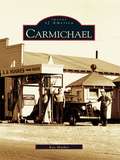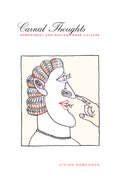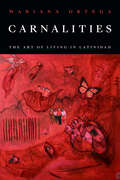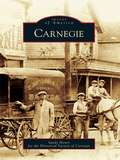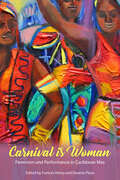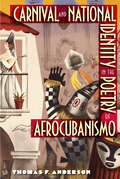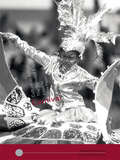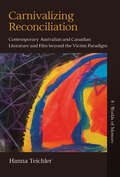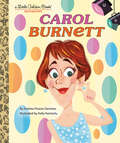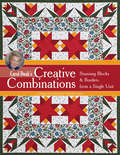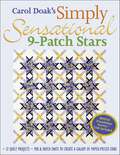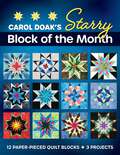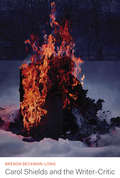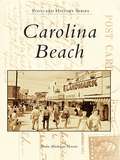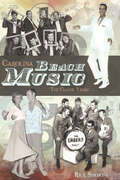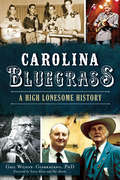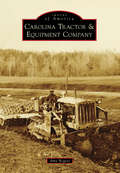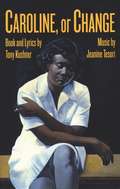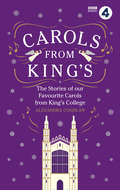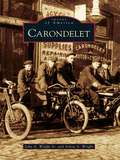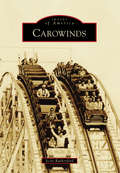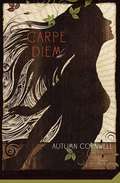- Table View
- List View
Carmichael (Images of America)
by Kay MutherThe early inhabitants of the Mexican land grant known as Rancho San Juan, sprawling alongside the American River, could never guess that their humble settlement would someday become a bustling and scenic suburb with some of California's most desirable real estate. Yet that is the tale of Carmichael, which evolved from an initial 2,000-acre purchase by founder Daniel W. Carmichael to the busy section of homes and businesses we know today. Showcased in this engaging volume of more than 200 vintage images are many aspects of life in Carmichael, from the wide-open pastures where roadside stands once offered fruits, vegetables, and eggs along today's Fair Oaks Boulevard to the 1920s service stations that sprang up, along with schools, churches, and shopping centers, to serve the burgeoning population of that era. The development of other important aspects of civic life, including road construction, community educational facilities, and shopping centers such as Crestview are explored in these pages as well.
Carnal Thoughts
by Vivian SobchackIn these innovative essays, Vivian Sobchack considers the key role our bodies play in making sense of today's image-saturated culture. Emphasizing our corporeal rather than our intellectual engagements with film and other media, Carnal Thoughts shows how our experience always emerges through our senses and how our bodies are not just visible objects but also sense-making, visual subjects. Sobchack draws on both phenomenological philosophy and a broad range of popular sources to explore bodily experience in contemporary, moving-image culture. She examines how, through the conflation of cinema and surgery, we've all "had our eyes done"; why we are "moved" by the movies; and the different ways in which we inhabit photographic, cinematic, and electronic space. Carnal Thoughts provides a lively and engaging challenge to the mind/body split by demonstrating that the process of "making sense" requires an irreducible collaboration between our thoughts and our senses.
Carnalities: The Art of Living in Latinidad
by Mariana OrtegaIn Carnalities, Mariana Ortega presents a phenomenological study of aesthetics grounded in the work of primarily Latinx artists. She introduces the idea of carnal aesthetics informed by carnalities, creative practices shaped by the self’s affective attunement to the material, cultural, historical, communal, and spiritual. For Ortega, carnal aesthetics offers a way to think about the affective and bodily experiences of racialized selves. Drawing on Gloria Anzaldúa, Chela Sandoval, José Esteban Muñoz, Alia Al-Saji, Helen Ngo, Maurice Merleau-Ponty, Roland Barthes, and others, Ortega examines photographic works on Latinx subjects. She analyzes the photography of Laura Aguilar, Verónica Gabriela Cárdenas, and Susan Meiselas, among others, theorizing photography as a carnal, affective medium that is crucial for processes of self-formation, resistance, and mourning in Latinx life. She ends with an intimate reading of photography through a reflection of her own crossing from Nicaragua to the United States in 1979. Motivated by her experience of loss and exile, Ortega argues for the importance of carnal aesthetics in destabilizing and transforming normative, colonial, and decolonial subjects, imaginaries, and structures.
Carnegie (Images of America)
by Historical Society of Carnegie Sandy HenryIn the late 19th century, the boroughs of Mansfield and Chartiers were situated south and west of Pittsburgh and divided by a creek. They merged to become one unified city, and a new name was sought. The community petitioned philanthropist Andrew Carnegie for financial assistance, and he responded generously. Thus, the town of Carnegie was founded on March 1, 1894. Throughout the decades that followed, Carnegie experienced rapid growth of industry, commerce, and population. Yet anyone who has ever resided there will boast of its small-town charm. The steel mills supported generations of families, who then struggled to adapt to a changing world when the plants closed down. Carnegie's hometown heroes include Pirates shortstop Honus Wagner and NFL coach Mike Ditka. Carnegie is a photographic essay that chronicles the town'shistory and abundant contributions to industry and transportation.
Carnie King: The Story of Patty Conklin and Conklin Shows
by John ThurstonThe story of the audacious showman who built the greatest carnival dynasty in North America.Enter the realm of the carnie king, Patty Conklin, the flamboyant founder of what would become the world’s largest carnival company. Patty started on the mean streets of New York selling peanuts before becoming a a small-time operator. Willing to try anything to promote his show, he established himself as a carnie celebrity. Winning the midway contract for the Canadian National Exhibition in 1937, he made it his personal world’s fair. It became the foundation for his son and grandson to expand Conklin Shows until they were playing the biggest fairs and exhibitions throughout North America. Carnie King begins with the birth of Joseph Renker to German immigrant parents, tells of his personal transformation into Patty Conklin, and follows his incredible life through to his death in 1970. It covers his company's history after Jim Conklin took over, expanded it beyond recognition, then handed it on to his own son.Not only a history of Conklin Shows, Carnie King explores how midways work and their commercial and popular presence in North America The story it tells is based on dozens of interviews with carnies and access to the Conklin archives. It includes anecdotes about a range of characters and insights about life on the midway. Carnie King is at once a revealing look at a unique part of twentieth-century culture and a vivid account of three generations of showmen and their dominance of midways across the continent.
Carnival Is Woman: Feminism and Performance in Caribbean Mas (Caribbean Studies Series)
by Frances Henry and Dwaine PlazaContributions by Darrell Gerohn Baksh, Jan de Cosmo, Frances Henry, Jeff Henry, Adanna Kai Jones, Samantha Noel, Dwaine Plaza, Philip W. Scher, and Asha St. Bernard Women are performing an ever-growing role in Caribbean Carnival. Through a feminist perspective, this volume examines the presence of women in contemporary Carnival by demonstrating not only their strength in numbers, but also the ways in which women participate in the event. While decried by traditionalists, the bikinis, beads, and feathers of “pretty mas’” convey both a newly found empowerment as a gendered resistance to oppression from men. Although research on Carnivals is substantial, especially in the Americas, the subject of women in Carnival as a topic of inquiry remains fairly new. These essays address anthropological and historical facets of women and their practices in the Trinidad Carnival, including an analysis of how women’s costuming and performance have changed over time. The modern costumes, which are well within the financial means of most mas’ players, demonstrate the new power of women who can now afford these outfits. In discussing the commodification and erotization of Carnival, the book emphasizes the unveiling of the female body and the hip-rolling sexual movements called winin or it. Through display of their bodies, contemporary women in Carnival express a form of female resistance. Intent on enjoying and expressing themselves, they seem invigorated by their place in the economy, as well as their sexuality, defying the moral controls imposed on them. Through an array of methods in qualitative research, including interviews, participant observation, and ethnography, this volume explains the new power of women in the evolution of Carnival mas’ in Trinidad amid the wider Caribbean diaspora.
Carnival and National Identity in the Poetry of Afrocubanismo
by Thomas F. Anderson“Traces the ways that Cuban poets dealt with issues of national identity, reflected in their views of Afrocubanismo, often in response to historical changes in public and official opinions on the most visual manifestation of Afro-Cuban culture: carnival.”—Choice “Uncovers a wealth of literary texts, primarily poems, that chart the impact of las comparsas, Afro-Cuban festival dances, on mainstream Cuban life. . . . Investigates the ways in which the relationship between racial and ethnic divisions, and between castes and classes, created a literary movement full to the brim with emotional and sensational resonances.”—Wasafiri “Underscores the sociopolitical and historical contexts of these poems which have shaped the literary production and message of the Afrocubanismo movement. . . . A tour de force.”—Callaloo “Successfully plumbs the position of the Afro-Cuban performer and brings into sharp relief the way politicians historically sought to affect all elements of Cuban culture.”—New West Indian Guide Carnival and National Identity in the Poetry of Afrocubanismo offers thought-provoking new readings of poems by seminal Cuban poets, demonstrating how their writings affected the development of a recognizable Afro-Cuban identity. Thomas Anderson examines the long-running debate between the proponents of Afro-Cuban cultural manifestations and the predominantly white Cuban intelligentsia, who viewed these traditions as “backward” and counter to the interests of the young Republic. Including analyses of the work of Felipe Pichardo Moya, Alejo Carpentier, Nicolás Guillén, Emilio Ballagas, José Zacarías Tallet, Felix B. Caignet, Marcelino Arozarena, and Alfonso Camín, this rigorous, interdisciplinary volume offers a fresh look at the canon of Afrocubanismo and offers surprising insights into Cuban culture during the early years of the Republic.
Carnival: Culture in Action – The Trinidad Experience (Worlds of Performance)
by Milla Cozart RiggioThis beautifully illustrated volume features work by leading writers and experts on carnival from around the world, and includes two stunning photo essays by acclaimed photographers Pablo Delano and Jeffrey Chock. Editor Milla Cozart Riggio presents a body of work that takes the reader on a fascinating journey exploring the various aspects of carnival - its traditions, its history, its music, its politics - and prefaces each section with an illuminating essay. Traditional carnival theory, based mainly on the work of Mikhail Bakhtin and Victor Turner, has long defined carnival as inversive or subversive. The essays in this groundbreaking anthology collectively reverse that trend, offering a re-definition of 'carnival' that focuses not on the hierarchy it temporarily displaces or negates, but a one that is rooted in the actual festival event. Carnival details its new theory in terms of a carnival that is at once representative and distinctive: The Carnival of Trinidad - the most copied yet least studied major carnival in the world.
Carnivalizing Reconciliation: Contemporary Australian and Canadian Literature and Film beyond the Victim Paradigm (Worlds of Memory #8)
by Hanna TeichlerCriminal justice inquiries may be the most historically dramatic means for coming to terms with traumatic legacies, but it is in the more subtle social and cultural processes of “memory work” that most individuals encounter historical reconciliation in practice. This book analyzes, within the realms of national literature and film, recent Australian and Canadian attempts to reconcile with Indigenous populations in the wake of forced child removal. As Hanna Teichler demonstrates, their systematic emphasis on the subjectivity of the victim is “carnivalesque,” temporarily overturning discursive hierarchies. Such fictions of reconciliation venture beyond simplistic narratives and identities defined by victimization, offering new opportunities for confronting painful histories.
Carnivalizing Reconciliation: Contemporary Australian and Canadian Literature and Film beyond the Victim Paradigm (Worlds of Memory #8)
by Hanna TeichlerTransitional justice and national inquiries may be the most established means for coming to terms with traumatic legacies, but it is in the more subtle social and cultural processes of “memory work” that the pitfalls and promises of reconciliation are laid bare. This book analyzes, within the realms of literature and film, recent Australian and Canadian attempts to reconcile with Indigenous populations in the wake of forced child removal. As Hanna Teichler demonstrates, their systematic emphasis on the subjectivity of the victim is problematic, reproducing simplistic narratives and identities defined by victimization. Such fictions of reconciliation venture beyond simplistic narratives and identities defined by victimization, offering new opportunities for confronting painful histories.
Carol Burnett: A Little Golden Book Biography (Little Golden Book)
by Andrea Posner-SanchezHelp your little one dream big with a Little Golden Book biography about the multitalented star Carol Burnett, the first woman to host a comedy-variety show! Little Golden Book biographies are the perfect introduction to nonfiction for preschoolers!This Little Golden Book about Carol Burnett—star of Broadway, movies, and her own award-winning TV show—is a celebration of a true comedy genius! This is a great read-aloud for young children as well as their parents and grandparents who grew up watching and loving The Carol Burnett Show. Look for Little Golden Book biographies about these other inspiring people:Willie NelsonHarriet TubmanLucille BallQueen Elizabeth IIBarack ObamaSonia SotomayorDr. FauciJoe BidenDolly PartonKamala HarrisMisty CopelandBetty WhiteFrida KahloRuth Bader GinsburgJackie RobinsonMartin Luther King Jr.
Carol Doak's Creative Combinations: Stunning Blocks & Borders from a Single Unit
by Carol Doak“Try Carol’s inspirational quilts projects by learning how to work with unit placement, how to paper piece and how to choose your fabrics.” —Fabrications Quilting for YouCarol Doak is back with something new for paper piecers! Learn how the same rectangular unit can work in dramatically different ways in the blocks and borders of your quilt. If you haven’t tried paper-piecing yet, you’ll discover how quickly and easily your quilt comes together with Carol’s foundation piecing technique. She provides tips for tools and fabrics, plus plenty of inspiration. Get creative with your own unit combinations—link to online patterns that give you the flexibility to change the size of your quilt, or design your own pattern“Doak is the doyenne of foundation paper piecing—a quilt-piecing technique that uses a paper foundation for precision stitching of quilt blocks . . . Most of the blocks are beginner friendly, and Doak’s expert guidance helps quilters new to the technique get started . . .This collection will appeal to quilters of all skill levels.” —Library Journal“Instead of giving designs for square quilt blocks, Carol Doak’s clever concept is to design rectangular paper-pieced units which can then be combined in different ways to make unique blocks or borders. Each unit is presented with multiple design possibilities, reinforcing their versatility.” —Quilters Newsletter
Carol Doak's Simply Sensational 9-Patch Stars
by Carol DoakYour lucky stars—the paper-pieced way! • Mix-and-match units, 50 NEW state star blocks, endless star possibilities! • You'll have stars in your eyes as paper-piecing expert Carol Doak brings you a galaxy of 9-patch stars • 12 sparkling quilt projects • Make perfect stars every time • Easy for beginners, splendid for advanced quilters • Bonus CD-ROM—print the patterns in different sizes, so you can star gaze to your heart's content
Carol Doak’s Starry Block of the Month: 12 Paper-Pieced Quilt Blocks, 3 Projects
by Carol DoakPaper piece perfection with Carol Doak's 12 Block of the Month stars! Paper piece stars like never before with Carol Doak’s 12 star Block of the Month! This booklet offers a curated introduction to paper piecing, featuring Carol’s expert instructions and a delightful selection of stars for each month. Mix and match the stars to suit your style, perfect for creating beautiful table runners and sampler quilts. Learn from best-selling author, inspiring teacher, and the Queen of Paper Piecing, Carol Doak This booklet is great for beginners, offering a quick introduction to paper piecing with Carol's stunning star blocks, just what you need to get started Use the 12 stars as a block-of-the-month challenge for yourself, your quilting circle, or your guild!
Carol Shields and the Writer-Critic
by Brenda Beckman-LongThroughout her literary and critical career, Canadian writer Carol Shields (1935-2003) resisted simple categorization. Her novels are elegant puzzles that confront the reader with the ambiguity of meaning and narrative, yet their position within Shields' critical feminist project has, until now, been obscured.In Carol Shields and the Writer-Critic, Brenda Beckman-Long illuminates that project through the study of Shields' extensive oeuvre, including her fiction and criticism. Beckman-Long brings depth to her analysis through close readings of six novels, including the award-winning The Stone Diaries. Elliptical, open-ended, and concerned with women writing about women, these novels reveal Shields' critique of dominant masculine discourses and her deep engagement with the long tradition of women's life writing. Beckman-Long's original archival research attests to Shields' preoccupation with the changing efforts of waves of feminist activism and writing.A much needed reappraisal of Shields's innovative work, Carol Shields and the Writer-Critic contributes to the scholarship on life writing and autobiography, literary criticism, and feminist and critical theory.
Carolina Beach
by Elaine Blackmon HensonCarolina Beach, North Carolina, has been a destination for beachgoers, boaters, and fishermen since the 1880s. Visitors came first by the combination of river steamers and a train and later by automobiles to seek respite from the summer's heat and the daily grind. This book shares the history of this seaside community through the postcards its visitors sent home. From the early handcolored cards printed in Germany to the modern chrome cards of today, we see the people and places of Carolina Beach.
Carolina Beach Music: The Classic Years
by Rick SimmonsJust as the dances of Beach Music have their twists and turns, so too do the stories behind the hits made popular in shag haunts from Atlantic Beach to Ocean Drive and the Myrtle Beach Pavilion. In Carolina Beach Music, local author and Beach Music enthusiast Rick Simmons draws on first-hand accounts from the legendary performers and people behind the music. Simmons reveals the true meaning behind "Oogum Boogum," uncovers just what sparked a fistfight between Ernie K. Doe and Benny Spellman at the recording session of "Te-Ta-Te-Te-Ta-Ta," and examines hundreds of other true events that shaped the sounds of Beach Music.
Carolina Bluegrass: A High Lonesome History
by Gail Wilson-Giarratano Larry Klein Pat AhrensIn the Carolinas, bluegrass is more than music--it's a way of life. The origins of the genre date back to the earliest frontier settlements, and banjo music appeared at dances in Greenville, South Carolina, as early as 1780. The genre was essential to socialization in the textile mills of both states. Old-time music of the Blue Ridge Mountains heavily influenced the sound. Bill Monroe, considered by many to be the father of bluegrass, began his recording career in Charlotte in 1936. Many of the most popular bands, such as the Hired Hands and Briarhoppers, regularly performed live on local television stations in Columbia, Spartanburg and Charlotte. Today, bluegrass festivals fill local calendars across the region. Author Gail Wilson-Giarratano uses interviews and the historic record to tell this unique and compelling story.
Carolina Tractor & Equipment Company
by Amy RogersFounded on honesty, hard work, conservative management, and family commitment, Carolina Tractor & Equipment Company was established in 1926 by L.M. Weisiger. "Mr. Les," as he was known, became an engineer for the South Carolina State Highway Department after serving in the US Army during World War I. To meet the growing demand for new roads during the mid-1920s, he formed Weisiger Paving Company and later, in 1930, purchased the controlling interest of Carolina Tractor. Under his leadership, Carolina Tractor & Equipment Company experienced great success and growth. Weathering the Depression and expanding across the state of North Carolina, the company opened additional offices in Asheville, Charlotte, Hickory, and Greensboro. In 1965, Mr. Les turned the company over to his son, Ed I. Weisiger Sr. Mr. Les chaired the company board until his death in 1980; his wife, Katharine, then took over. True to its historical roots, Carolina Tractor & Equipment Company remains a local, family-owned company aligned with the interests of the customers it serves throughout North Carolina.
Caroline, or Change
by Tony Kushner Jeanine Tesori"There are moments in the history of theatre when stagecraft takes a new turn. I like to think that this happened for the American musical last week, when Tony Kushner's Caroline, or Change (at the Public), a collaboration with composer Jeanine Tesori and the director George C. Wolfe, bushwhacked a path beyond the narrative end of the deconstructed, overfreighted musicals of the past thirty years."--John Lahr, The New YorkerLouisiana, 1963: A nation reeling from the burgeoning Civil Rights Movement and the Kennedy assassination. Caroline, a black maid, and Noah, the son of the Jewish family she works for, struggle to find an identity for their friendship. Through their intimate story, this beautiful new musical portrays the changing rhythms of a nation. Tony Kushner and composer Jeanine Tesori have created a story that addresses contemporary questions of culture, community, race and class through the lens and musical pulse of the 1960s.Tony Kushner is best known for the two-part masterwork, Angels in America, recently produced by HBO as a six-hour television event, directed by Mike Nichols to universal acclaim. His other plays include Homebody/Kabul, A Bright Room Called Day and Slavs!; as well as adaptations of Corneille's The Illusion, Ansky's The Dybbuk, Brecht's The Good Person of Szechuan and Goethe's Stella. Current projects include: Henry Box Brown or The Mirror of Slavery and St. Cecilia or The Power of Music. He recently collaborated with Maurice Sendak on an American version of the children's opera, Brundibar. He grew up in Lake Charles, Louisiana, and he lives in New York.Jeanine Tesori wrote the score for Thoroughly Modern Millie, which won the 2002 Tony and Drama Desk Awards for Best Musical and the multiple-award-winning Violet.
Carols From King's
by Alexandra CoghlanThe exquisite sound of a lone chorister singing Once in Royal David’s City amid the candlelit chapel of King’s College, Cambridge, marks the start of the Christmas festivities for millions of people round the globe. Broadcast at 3pm on Christmas Eve, A Festival of Nine Lessons and Carols provides a precious moment of tranquillity amongst the bustle of the festive season. Take a journey through the fascinating history of carols, from the very first - sung by the angels to the shepherds at Bethlehem - to anecdotes from contemporary King's choristers. Learn how carols have evolved from pagan songs to become one of our nation's most sacred treasures. Accompanied by lyrics and music and compiled in conjunction with Radio 4 and King’s College Chapel, Carols From King’s is the official companion for fans of Christmas and carols alike.
Carondelet
by John A. Wright Sr. Sylvia A. WrightClement Delor de Treget, a Frenchman, founded Carondelet in 1767 and named the village in honor of Baron Francis Louis de Carondelet, the Spanish governor of the Louisiana Territory. Due to its prime location at the confluence of the River Des Peres and the Mississippi River, Carondelet attracted a wide array of industries and a diverse population where racial lines were often blurred and ethnic groups peacefully coexisted. The community hascontributed greatly to American history from the site of construction of the Civil War ironclad boats to the location of the American kindergarten movement. Today the community is striving to preserve its proud heritage and build on the strength of its diverse population. The historic images in this book illustrate the city's founding and development from the first French settlers to the coming of Germans, Irish, Italians, African Americans, and Spanish, its annexation to the city of St. Louis in 1870, its economic hardships, and its present revitalization.
Carowinds (Images of America)
by Scott RutherfordLocated near Charlotte, Carowinds has long been considered the "Thrill Capital of the Southeast!" The brainchild of Earl Patterson Hall, a self-made businessman and real estate developer, Carowinds is an exciting day for children and adults alike. Inspired by a trip to Disneyland in 1957, Hall envisioned an amusement park for the citizens of the Carolinas. In 1973, after four years of planning and construction, Carowinds opened to the public on a large site that straddles the North Carolina-South Carolina border. Throughout the 1970s, visitors enjoyed rides such as the Witchdoctor and White Lightnin'. Currently, the park features rides, shows, and attractions for all, including Intimidator, the tallest and fastest coaster in the Southeast. Carowinds showcases the rich history of this Carolina amusement park celebrating its 40th anniversary in 2013.
Carpe Diem
by Autumn CornwellI've got my entire life planned out for the next ten years including my PhD and Pulitzer Prize, claims 16-year-old overachiever Vassar Spore, daughter of overachiever parents, who in true overachiever fashion named her after an elite women's college. Vassar expects her sophomore summer to include AP and AAP (Advanced Advanced Placement) classes. Surprise! Enter a world-traveling relative who sends her plans into a tailspin when she blackmails Vassar's parents into forcing their only child to backpack with her through Southeast Asia. On a journey from Malaysia to Cambodia to the remote jungles of Laos, Vassar sweats, falls in love, hones her outdoor survival skills, and uncovers a family secret that turns her whole world upside-down. Vassar Spore can plan on one thing: she'll never be the same again.
Carpentry and Joinery Book 1
by David R. BatesThis book provides the apprentice or trainee carpenter and joiner with the basic technical knowledge necessary to complete the first half of a City and Guilds Course in Carpentry and Joinery. It will also be a useful reference to any persons studying for examinations, or simply wishing to further their knowledge in one of the associated areas, such as wood machining, cabinet making or general building construction. Dealing with the basic skills and techniques employed in the present day construction industry, the text assumes little prior knowledge of the subject, but lays before the reader a simple, straight forward and readable out of the skills, tools, materials and methods likely to be used or encountered in the workshop, on site or during studies at home or in college.
